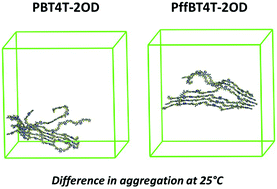Impact of solution temperature-dependent aggregation on the solid-state packing and electronic properties of polymers for organic photovoltaics†
Abstract
The performance of a bulk-heterojunction organic solar cell critically depends on the morphology of the active layer. The solution temperature-dependent aggregation characteristics of a series of polymer donors have been recently exploited as an effective protocol for morphology control in high-efficiency devices. Here, we use an approach combining molecular dynamics simulations and long-range corrected density functional theory calculations to investigate the impact of solution temperature-dependent aggregation on the polymer solid-state packing and electronic properties. We consider two representative polymer systems: (i) PffBT4T-2OD (poly[(5,6-difluoro-2,1,3-benzothiadiazol-4,7-diyl)-alt-(3,3′′′-di(2-octyldodecyl)-2,2′;5′,2′′;5′′,2′′′-quaterthiophen-5,5′′′-diyl)]), and (ii) PBT4T-2OD (poly[(2,1,3-benzothiadiazole-4,7-diyl)-alt-(3,3′′′-di(2-octyldodecyl)-2.2′;5′,2′′;5′′,2′′′-quarterthiophen-5,5′′′-diyl)]), where the fluorine atoms on the benzothiadiazole moieties of PffBT4T-2OD are replaced with hydrogen atoms. We find that both temperature-dependent aggregation and the presence of fluorine atoms are important in determining the nature of the solid-state packing and the electronic properties in the polymer phases. Our results are consistent with the experimental data that show that PffBT4T-2OD aggregates at lower temperatures and leads to higher OPV efficiency.

- This article is part of the themed collection: Functional Organic Materials for Optoelectronic Applications


 Please wait while we load your content...
Please wait while we load your content...
